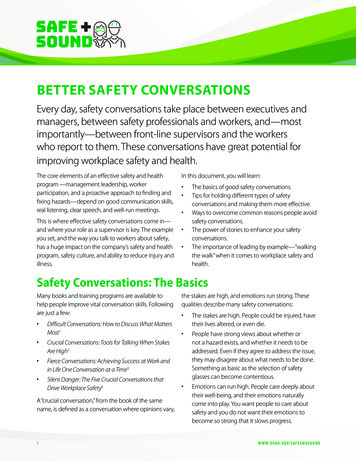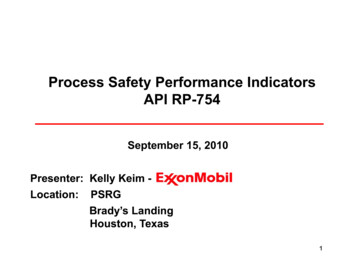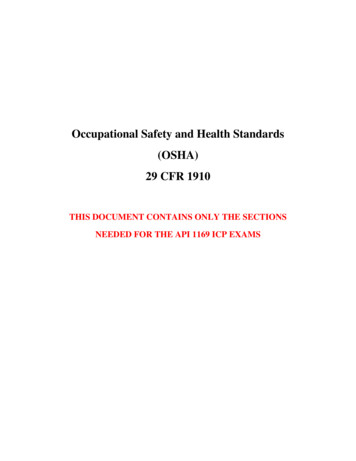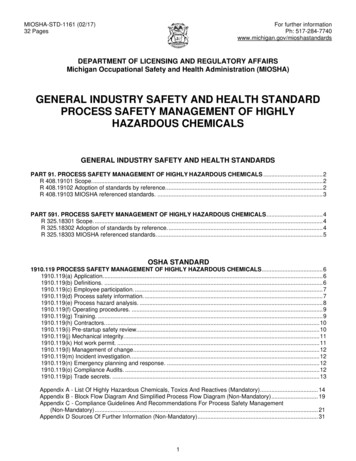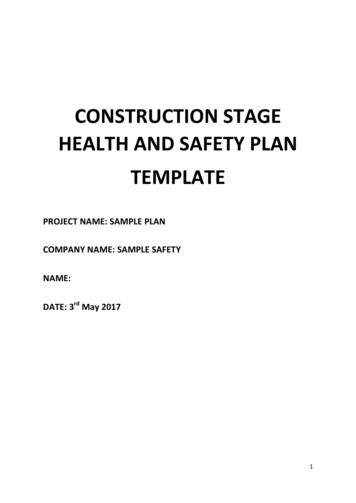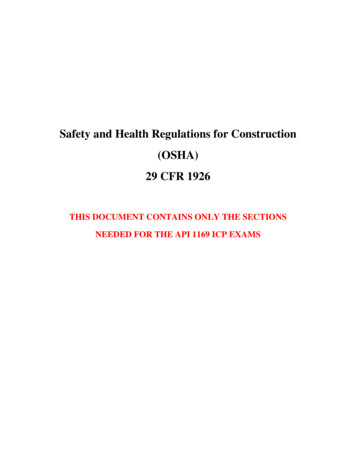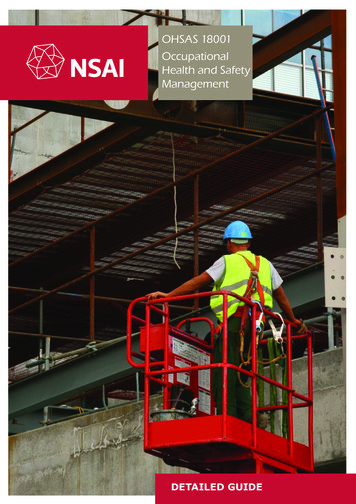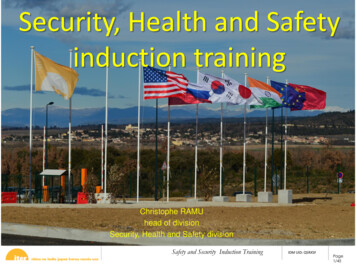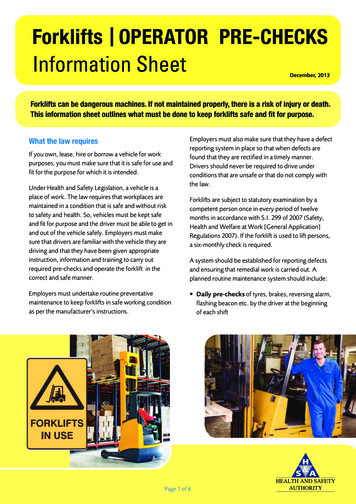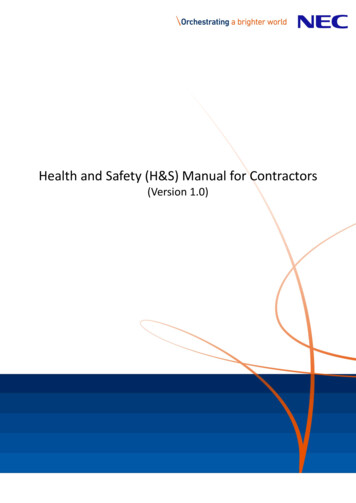
Transcription
Health and Safety (H&S) Manual for Contractors(Version 1.0)
Document Change HistoryDocument NumberRevisionChange Description1 First Issue2 NEC Corporation 2016EMD-3400Effective dateAugust 2016
Table of Contents1.Purpose . 42.Scope . 43.Definitions and Acronyms. 54.Requirements for all Projects. 64.1General Requirements . 64.2Training and Qualifications. 74.3Emergency Response . 74.4Notification . 84.5Risk Assessment . 84.6Site Inspections / Corrective Actions / Post Job Evaluations. 95.Specific Requirements for Carrier and System Integration Business . 96.Programs & Specific Requirements . 107.36.1Work in Inclement Weather . 106.2Chemical Management . 116.3Barricades, Signs & Perimeter Guarding . 126.4Confined Space Entry & Rescue . 136.5Personal Protective Equipment (PPE) . 136.6Electrical Safety. 156.7Overhead Power Lines . 166.8Safe Operation of Mechanical & Electrical Equipment . 166.9Rigging Operations . 176.10Crane Operation . 176.11Excavation and Trenching . 196.12Fall Protection, Tower Climbing & Ladder Safety . 206.13Work at Height. 226.14Fire Protection . 236.15Waste and Hazardous Waste . 236.16Radio Frequency (“RF”) Safety . 246.17Road Safety . 25Supplier Personnel . 25 NEC Corporation 2016
1. PurposeThis manual sets out NEC Group (NEC) expectations, in areas of Health and Safety (H&S), of allcontractors of NEC as defined in the scope and provides guidance in how these expectations canbe met.The contractor shall meet these H&S requirements when conducting work under contract to or onbehalf of any entities related to or affiliated with NEC. These requirements do not supersede anyother requirements, such as those described in applicable contracts between NEC and thecontractor or in the applicable national or state laws and/or regulations, but are intended tocomplement them.To align with the NEC H&S Policy, NEC requires that its contractors:Øcomply with all applicable H&S laws, regulations and industry standards; andØcomply with all H&S requirements contained in the contract between the applicable NECEntity and this manual. In the event of a conflict between the terms and conditions of anysuch contract and this document, the terms and conditions of such contract shall prevail.Contractors are responsible for the health and safety of their employees, its subcontractors (whereapplicable), members of the public and others who may be affected by its activities, and for thesafe and environmentally acceptable performance of their work.NEC believes in “zero accidents” with respect to health and safety while performing work for NECor NEC’s customers. All contractors and their subcontractors are required to strictly observe allhealth and safety requirements, all of NEC’s requirements and any mandatory health and safetyrequirements of NEC’s customer when working in NEC’s customer premises or on behalf of NEC orits customers. This requirement extends to all levels of subcontracting done by the contractor.Circumventing safety procedures and not utilizing required safety equipment or personalprotective equipment (PPE) will not be tolerated. The consequences for contractors that fail toobserve safety requirements will be disciplinary in nature up to and including termination of thecontract. A breach of safety requirements will be deemed to be a breach of contract with NEC.Contractors shall ensure that H&S hazards and risks are properly identified, assessed, controlledand evaluated prior to any work begins. Only applicably competent / certified persons mayperform the specified activities.2. ScopeThe requirements outlined in this document apply to all NEC contractors and can be used as aguidance document for other works / services including, but not limited to, construction activities,equipment installation or de-installation, maintenance or repair activities for or on behalf of NECand its customers.4 NEC Corporation 2016
3. Definitions and AcronymsThe following definitions apply to this document:NEC – NEC or the NEC subsidiaries or affiliates for which the contractor is working.Authorized – Those persons permitted in a work area by NEC or the contractor because they areaware of the potential hazards, the precautions to be taken and they possess the requiredcertifications and licenses as per regulatory requirements (e.g., electricians, tower climbers, craneoperators, aerial lift operators).Competent Person – An individual who, by way of training, education and experience, isknowledgeable of applicable standards, capable of identifying workplace hazards or environmentalaspects relating to the specific operation, is designated by the employer and has the authority totake appropriate corrective actions.Critical Lift - Any lift: utilizing multiple cranes; exceeding 85%*1 of total capacity of the crane at liftradius; over an occupied structure or public street; of lifting an item of high value or longreplacement time.Dynamic Risk Assessment - The continuous process of identifying hazards, assessing risk, takingaction to eliminate or reduce risk, monitoring and reviewing, in the rapidly changing circumstancesof an operational incident.Hot work - Any work involving burning, welding, torch cutting, grinding where sparks areproduced, soldering, or brazing in construction, maintenance and fabrication.High risk - Refers to a risk level that is not acceptable, after evaluating the risk of a work activity,and must be mitigated to at least a medium level before the work begins. Risk control measuresshould not be overly dependent on PPE and management review is required prior to workbeginning.Inclement weather - The existence of rain, such as typhoons and rainstorms or abnormal climaticconditions (whether they be those of hail, snow, cold, high wind, severe dust storm, lightening,extreme high temperature or the like or any combination thereof) by virtue of which it is either notreasonable or not safe for workers exposed thereto to continue working whilst the same prevail.Lost Time Injury (LTI) - An occupational injury or illness resulting in lost productive worktime. Aninjury is considered an LTI only when the employee is not able to perform the regular work duty.Medium risk - Refers to a risk level that is tolerable but careful evaluation of hazards associatedwith the work activity must be carried out to ensure the risk is reduced to as low as reasonablypracticable. Interim control measures like administrative controls and PPE may be used while longterm control measures are being established.Method Statement – Sometimes referred to as a Safe System of Work” (SSOW), describing the waya work task or process is to be completed. As a minimum, details site location, landlord’s details,known hazards on site and details of nearest hospital or medical centre. The method statementshould outline the hazards involved and include a step by step guide on how to do the job safely.The method statement must also include which control measures have been introduced to ensure1Definitions. - 1926.751 - Occupational Safety and Health disp.show document?p table STANDARDS&p id 107875 NEC Corporation 2016
the safety of anyone who is affected by the task or process.Radio Frequency (RF) - Electromagnetic emissions that may present a health impact from radiotechnologies and, more specifically, mobile telephony.Safety Data Sheets (SDSs) – An important component of product stewardship and occupationalsafety and health. It is intended to provide workers and emergency personnel with procedures forhandling or working with chemical substances in a safe manner, and includes information such asphysical data (melting point, boiling point, flash point, etc.), toxicity, health effects, first aid,reactivity, storage, disposal, protective equipment, and spill-handling procedures.Stand-off distances – Distances that workers should maintain from potentially energizedtransmitting antennas to ensure that exposure to RF energy remains well below appropriateMaximum Permissible Exposures (MPEs).Supplier Personnel – Includes, but is not limited to, supplier’s direct, full time, part-time,temporary and contracted employees, consultants, contractors and any other third parties hired orused by the supplier to provide the services or perform the work at the NEC assigned work sites.4. Requirements for all Projects4.1 General Requirementsa. As noted above in Section 1, the requirements set forth in this manual are theminimum expectations of NEC. No NEC entity may make representations, guarantees,or warranties that these requirements, by themselves, represent appropriate safetypractices as may be reasonable and customary in the industry, nor shall anystatements by any NEC employees or their agents be interpreted as making any suchrepresentation, guarantee, or warranty. The Contractor remains liable for the safeperformance of the work and NEC reserves all rights and does not waive any claimsregarding the safe performance of the work.b. The contractor shall take all reasonable actions to prevent personal injuries andenvironmental incidents associated with the work to be performed.c. The contractor shall designate an H&S representative who will be responsible forensuring that all H&S requirements are followed at all work sites includingmonitoring, inspection and supervision of next tier contractors. The contractor maydesignate one of its contractors’ employees as the H&S representative, but thecontractor will remain directly responsible for the H&S performance and compliancewith this manual and all applicable laws and regulations. Contractors shall hold asafety briefing (daily tool box safety meeting) covering the precautions to take forthat day’s work.d. Safe access and egress to the work site to be maintained at all times.6 NEC Corporation 2016
e. All H&S documentation related to the work to be performed by a contractor must beprovided to NEC or affiliates upon request.4.2 Training and QualificationsTo improve each worker’s awareness and knowledge of safe work and the prevention ofaccidents and incidents, NEC requires that all persons working for and / or on behalf of theContractor have appropriate training. For example measures to protect workers fromdangers in the work place, requirements to handle machines and /or dangerous substancesand also have the appropriate legal qualifications to perform the work where required.a.The contractor shall ensure that their employees and the empl
NEC – NEC or the NEC subsidiaries or affiliates for which the contractor is working. Authorized – Those persons permitted in a work area by NEC or the contractor because they are aware of the potential hazards, the precautions to be taken and they possess the required certifications and licenses as per regulatory requirements (e.g., electricians, tower climbers, crane operators, aerial .

